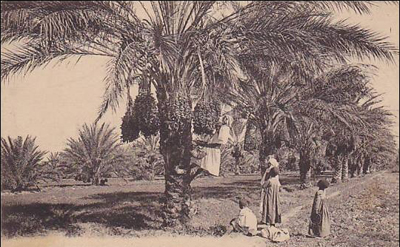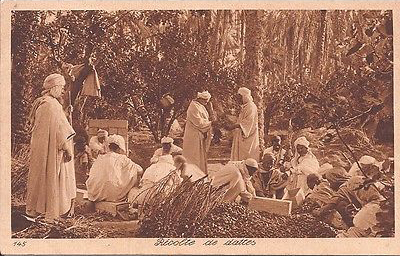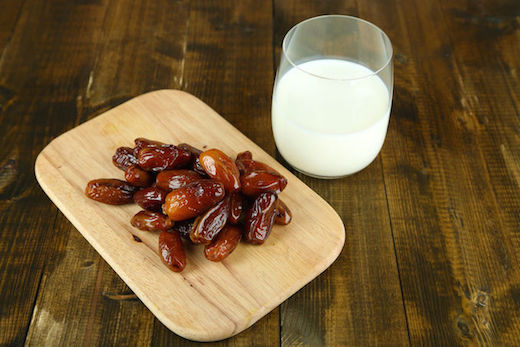

Known since antiquity, the origin of the date palms goes back to western India and the Persian Gulf. Today, it is found in the warm regions of North Africa, the Sahara and the Middle East. Palm trees are highly resourceful.
Symbol of fertility and prosperity of the Saharan and Pre-Saharan zones, the date palm, called “the tree of life” is the nutrient tree of the populations living near the deserts because it is one of the rare plants able to survive in the inhospitable desert climate. It is a large tree measuring 15 to 20m in height.
There are male palms and female palms but it is necessary to wait until flowering to distinguish them. A single male palm tree can pollinate a hundred females, hence the predominance of these in the palm grove.
The sown palm cores become palm trees, but these are rarely the palm trees that we expect. The Phoenicians did not rely on chance of planting and took care of planting female palms bearing dates of their choice, using a kind of cuttings that can multiply plantings.

Dates require a lot of heat and sunshine for ripening. It is necessary to wait for the heat of the summer and that of the autumn season so that the precious fruits reach their definitive size, become yellow and acquire their sweet flavor. Tunisia operates as one of the largest producers of dates in the world, and is the Mediterranean country date producer par excellence, thanks to its dry and hot climate that promotes the cultivation of date palm in its oases.
The Tunisian oases offer a healthy ecological system where the palm tree produces a delicious and valuable fruit. About 150 varieties of dates are cultivated in the southern palm groves that form the characteristic vegetation of the oases and are concentrated in the oases of Kebili and Tozeur.
The most commercialized date varieties are:
– Deglet Ennour
– Allig
– Khouat Allig
– Kenta
The excellent conservation capacity of Deglet Ennour variety in a cold room allows it to be marketed all year long.

Deglet Ennour is the queen of all dates. It is traditionally called the bright fruit of light for its translucent blonde color, the softness of its appearance, the elegance of its shape and its specific flavor.
Deglet Ennour is a fleshy, mellow and very sweet fruit. It is the most popular variety in the world for its superior quality and unique taste.
It is the only variety that can be marketed in its natural twigs form.
In the commercial field, “common dates varieties” is used to differentiate Deglet Ennour from the rest of dates varieties.
Allig is picked in November. It is a particularly tasty variety, long in form, smooth in appearance, dark mahogany in color, soft and fleshy, with a semi-smooth texture.
Khouet Allig has a texture, color and taste similar to those of the Allig variety, hence its name. This variety is slightly thinner and less sweet with a moderate water content.
Kenta has a light golden color and attractive appearance. This date variety has an early maturity, is less sweet than all other varieties and its texture is semi-dry.









The dates are often called the miraculous fruits, as the benefits of this fruit on human health are multiple and even proven through scientific studies. It is a fruit very rich in nutrients, minerals, oligo elements and vitamins essential for the proper functioning of our body and for the prevention of several diseases.
The date is a dry fruit that provides a significant energy intake. Indeed, 100g of dates has the equivalent of about 300 calories. These calories come mainly from the carbohydrates of the date. These sugars naturally present in the fruit have the effect of stimulating the energy of the body. Dates are therefore a favorite food for individuals practicing sports.
It is recommended to consume 20 to 35 grams of dietary fiber per day, which can be provided by dates, given their richness in dietary fiber that come in two soluble and insoluble forms.
Insoluble fiber plays an important role in intestinal regularity and the prevention of constipation. Soluble fiber helps reduce cholesterol levels and regulates glucose and insulin levels. As a result, they can help reduce the risk of cardiovascular disease.

Dates are very rich in minerals and especially in potassium, making it a food of choice for athletes and older individuals. Potassium is one of the main ingredients in improving a healthy and sensitive nervous system, and it also promotes the speed and alertness of brain activity. The risk of stroke can be reduced by up to 40% with sufficient potassium intake (around 400 mg per day).
Dates are also rich in iron. In fact, a consumption of 100 grams contains 0.90 g of iron, or 11% of the recommended daily intake. Iron plays a vital role in the body as it is used for the production of red blood cells that carry all nutrients to cells in the body, and is used to produce hemoglobin, which provides oxygen to the organs. They also contain selenium, manganese and copper that are essential to healthy bone development and strength.
Dates also contain vitamins such as thiamine, riboflavin, niacin, folic acid and vitamin A. These vitamins help maintain a healthy body and amino acids like alanine, arginine, glycine, serine, or valine. These amino acids have many virtues, such as reducing blood pressure.








